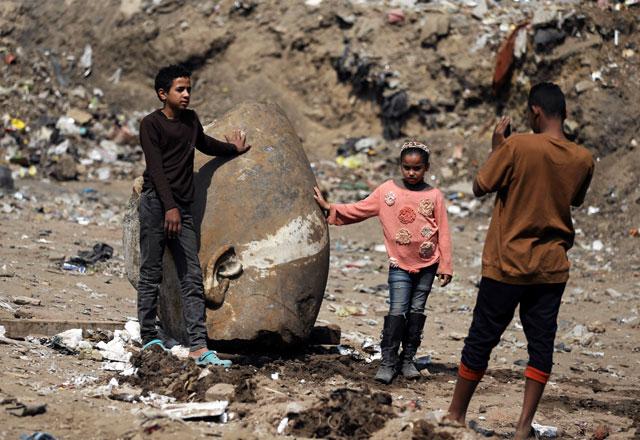You are here
Transfer of sphinxes to Cairo square stirs controversy
By AFP - May 12,2020 - Last updated at May 12,2020

Tourists stroll along the avenue of the ram-headed sphinxes, symbolising the ancient Egyptian god Amun, at the Karnak temple complex in Egypt's southern city of Luxor (AFP photo)
CAIRO — In a bustling square of Egypt's capital, four sphinx-like statues stand in wooden crates ahead of a planned unveiling ceremony following their controversial transfer from historical sites.
With the bodies of lions and heads of rams, the statues had for millennia graced Karnak temple in the southern city of Luxor representing the ancient Egyptian god "Amun".
This month, the restored sandstone statues were moved to Cairo's landmark Tahrir Square, the epicentre of a 2011 popular uprising that toppled longtime ruler Hosni Mubarak.
"I am against the moving of Luxor monuments. I was especially saddened by their relocation," legislator Ahmed Idris from the city told AFP.
"Luxor has long been like an open museum which should be developed and its monuments' historical value are tied to the city," said Idris.
The statues will be the square's centrepieces, along with a 19-metre-tall pink granite obelisk of the famed Ramses II.
The 3,000-year-old obelisk -- of Ramses II facing an ancient deity as well as inscriptions of his titles -- was moved from a Nile Delta archaeological site.
The relocations which came as part of government plans to renovate Tahrir Square have drawn wide criticism from archaeologists and activists.
Some petitioned President Abdel Fattah Al Sisi to stop the transfer.
Others including lawyers from a rights group filed a lawsuit citing a 1964 Venice Charter on the conservation and restoration of monuments, saying the move could "jeopardise the priceless artefacts".
Egypt signed the charter, adopted by UNESCO, in 1974.
'A touch of civilisation'
A frenetically busy square, Tahrir in downtown Cairo has long been associated with blaring car horns, traffic jams and exhaust fumes.
It stands a short stroll away from the Egyptian Museum, a tourist magnet which holds a vast collection of precious relics.
A staging ground for major protests in Egypt, the square has undergone multiple phases of renovation since the 2011 uprising.
Its renovation plan includes unifying building facades, removing street advertisements and an overhaul of its lighting.
In December, Sisi said the transfer of artefacts would add "a touch of civilisation" to the site.
But fears have grown over possible damage to the monuments.
"The high pollution in Tahrir Square will ruin the antiquities and accelerate their deterioration," Egyptologist Monica Hanna said in a Facebook post in December.
"A monument's value is diminished when removed from its original historical context and becomes an ornament rather than a monument," she said.
Egyptian architect Ayman Badr has said the square does not need "to be adorned with historical elements" as it "already holds historical value".
'A great honour'
Antiquities and Tourism Minister Khaled Al Anani has dismissed warnings that the monuments could be vandalised or be affected by pollution.
Ancient relics in Egyptian museums or public spaces often suffer damage by graffiti, engravings or just being frequently touched.
"No-one will be able to touch them. They will be placed on a high pedestal and surrounded by a water fountain," Anani told a private television channel in March.
He said they would undergo regular restoration and maintenance.
The statues were not among those lined up on the famed Kebash (rams) avenue linking Karnak and Luxor temples, according to the minister.
Mahmoud Zaki, a tour guide from Luxor, also sided with those defending the transfers.
"We exhibit artefacts abroad for foreigners to enjoy... and now it's a great honour that antiquities from Karnak temple adorn Egypt's most popular square," he told AFP.
An unveiling ceremony is planned but an official date has yet to be announced.
"It's nonsensical that [Egyptian] obelisks could be found in public spaces across the world and none of them stands in Egypt's most popular square," said antiquities expert Ali Abu Deshish.
Related Articles
CAIRO — Archaeologists from Egypt and Germany have found a massive eight-metre statue submerged in ground water in a Cairo slum that they sa
CAIRO — Egypt on Thursday shifted a colossal statue of legendary Pharoah Ramses II into place at the entrance to a new museum in Cairo that
LUXOR, Egypt — Egypt unveiled on Thursday a road lined with hundreds of ram-headed sphinx statues dating back more than 3,000 years, in a gr

















